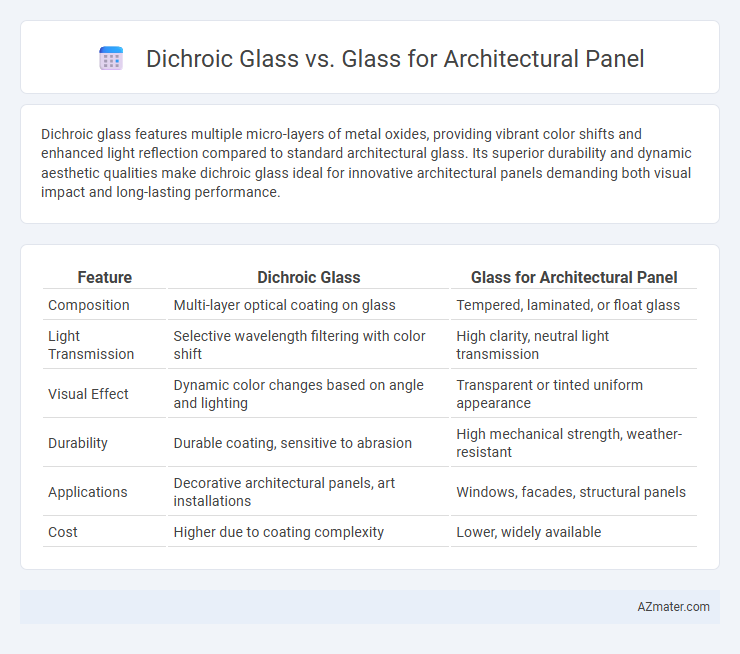Dichroic glass features multiple micro-layers of metal oxides, providing vibrant color shifts and enhanced light reflection compared to standard architectural glass. Its superior durability and dynamic aesthetic qualities make dichroic glass ideal for innovative architectural panels demanding both visual impact and long-lasting performance.
Table of Comparison
| Feature | Dichroic Glass | Glass for Architectural Panel |
|---|---|---|
| Composition | Multi-layer optical coating on glass | Tempered, laminated, or float glass |
| Light Transmission | Selective wavelength filtering with color shift | High clarity, neutral light transmission |
| Visual Effect | Dynamic color changes based on angle and lighting | Transparent or tinted uniform appearance |
| Durability | Durable coating, sensitive to abrasion | High mechanical strength, weather-resistant |
| Applications | Decorative architectural panels, art installations | Windows, facades, structural panels |
| Cost | Higher due to coating complexity | Lower, widely available |
Introduction to Dichroic Glass and Standard Glass
Dichroic glass is a multi-layered material coated with micro-thin metallic oxides that selectively reflect and transmit different wavelengths of light, creating vibrant color shifts visible from various angles. Standard glass, typically annealed or tempered, is clear and lacks the color-shifting properties, providing primarily transparency and structural support in architectural panels. The unique optical effects of dichroic glass make it ideal for decorative applications, while standard glass is favored for its strength, cost-efficiency, and simplicity in functional architectural designs.
What is Dichroic Glass?
Dichroic glass is a multi-layered glass that selectively reflects and transmits light, creating dynamic color shifts depending on the viewing angle and lighting conditions. This optical property results from thin-film coatings of metal oxides applied during the manufacturing process, producing vibrant, iridescent effects ideal for architectural panels. Unlike standard glass, dichroic glass enhances aesthetic appeal and visual impact in building facades, interiors, and decorative installations.
Characteristics of Standard Architectural Glass
Standard architectural glass typically features high durability, thermal insulation, and clarity, providing strength and energy efficiency for building facades and interior partitions. Unlike dichroic glass, which displays shifting colors and light diffraction due to its multi-layer coating, standard architectural glass maintains consistent transparency and color neutrality. Its characteristics include UV resistance, ease of maintenance, and compatibility with safety treatments like tempering and lamination for enhanced impact resistance.
Visual Appearance: Color and Light Effects
Dichroic glass in architectural panels offers dynamic color shifts and vibrant light reflections, changing hues depending on the angle of view and light source, creating a visually captivating and interactive facade. Standard glass typically provides a transparent or tinted appearance with consistent color and minimal light interaction, lacking the multichromatic brilliance found in dichroic variants. The unique optical properties of dichroic glass enhance aesthetic appeal and can transform architectural spaces through continuously evolving visual effects.
Durability and Strength Comparison
Dichroic glass offers enhanced durability and strength compared to traditional glass due to its multiple micro-layers of metal oxides, which provide increased resistance to impacts and environmental stress. The coating on dichroic glass also contributes to better protection against UV rays, reducing the likelihood of degradation over time in architectural panels. While both materials are suitable for building facades, dichroic glass's superior structural integrity and longevity make it a preferred choice for high-performance architectural applications.
Energy Efficiency and Thermal Performance
Dichroic glass enhances architectural panels by selectively filtering light, reducing solar heat gain and improving energy efficiency compared to standard glass. Its multiple micro-layers alter light transmission and reflection, which contributes to lower cooling loads and better thermal performance in buildings. This advanced optical property helps maintain indoor temperatures more effectively, supporting sustainable design goals.
Cost Differences and Budget Considerations
Dichroic glass panels for architectural use typically have higher upfront costs compared to standard glass due to their complex manufacturing processes involving multiple thin-film coatings that create color-shifting effects. Budget considerations should account for potential long-term savings from dichroic glass's enhanced aesthetic appeal and light management properties, which may reduce lighting costs and increase property value. Standard glass offers a more cost-effective solution for projects with strict budget limits but lacks the unique visual and energy efficiency benefits of dichroic glass.
Suitability for Interior vs. Exterior Applications
Dichroic glass offers dynamic color-shifting properties due to its multiple ultra-thin layers of metal oxides, making it highly suitable for interior architectural panels where visual impact and artistic expression are prioritized. Standard glass, with its consistent transparency and durability, is better suited for exterior applications requiring weather resistance, UV protection, and structural integrity. The suitability of dichroic glass for exterior use depends on additional coatings or laminations to enhance its durability against environmental elements.
Design Versatility and Customization Options
Dichroic glass offers superior design versatility for architectural panels through its ability to display multiple colors that change depending on the angle of light, creating dynamic visual effects unattainable with traditional glass. Customization options are extensive, including various color combinations, coatings, and patterns that can be tailored to specific aesthetic and functional requirements. In contrast, standard glass panels provide more limited customization, typically restricted to tinting, texturing, or laminations without the multi-hued, reflective properties inherent to dichroic glass.
Choosing the Best Glass for Architectural Panels
Dichroic glass offers dynamic color shifts and light-reflecting properties ideal for creating visually striking architectural panels that enhance aesthetic appeal and spatial experience. Standard glass panels provide durability, clarity, and cost-effectiveness, suitable for projects prioritizing structural function and natural lighting. Selecting the best glass for architectural panels depends on balancing design intent, environmental interaction, and budget constraints to ensure optimal performance and visual impact.

Infographic: Dichroic glass vs Glass for Architectural panel
 azmater.com
azmater.com